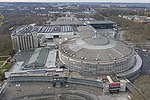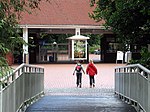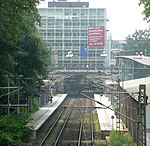Dortmund Signal-Iduna-Park station
North Rhine-Westphalia railway station stubsPages with no open date in Infobox stationRailway stations in DortmundRailway stations in Germany opened in 1952

Dortmund Signal-Iduna-Park is a railway station on the Dortmund–Soest railway situated close to Signal Iduna Park stadium (also known as Westfalenstadion) in Dortmund in western Germany. The station was called Dortmund Westfalenhalle before December 2006. It is served by regional railway lines of Deutsche Bahn.
Excerpt from the Wikipedia article Dortmund Signal-Iduna-Park station (License: CC BY-SA 3.0, Authors, Images).Dortmund Signal-Iduna-Park station
Bolmker Weg, Dortmund Innenstadt West
Geographical coordinates (GPS) Address Nearby Places Show on map
Geographical coordinates (GPS)
| Latitude | Longitude |
|---|---|
| N 51.490555555556 ° | E 7.4575 ° |
Address
Dortmund Signal-Iduna-Park
Bolmker Weg
44139 Dortmund, Innenstadt West
North Rhine-Westphalia, Germany
Open on Google Maps











